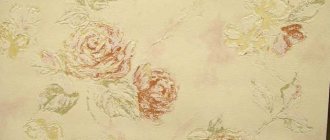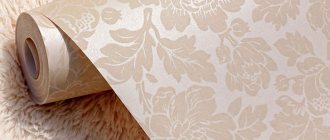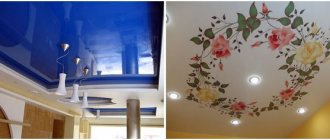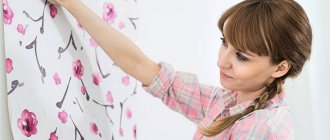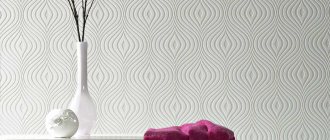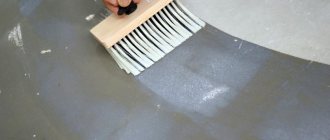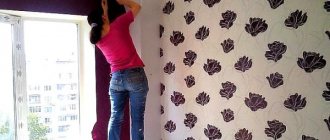There are a great variety of finishing materials for walls today. But consumers, trying to compensate for the lack of comfort in cramped apartments, are choosing modern solutions that can help turn even the smallest room into a space filled with sophistication and comfort.
One of these wall covering options is textile wallpaper. They not only look great, but also have many positive characteristics. Canvases allow you to create panels or a seamless surface on the walls. The latter effect can be achieved thanks to stripes up to more than three meters wide. If your budget is limited, you should ask how to glue textile wallpaper, because the services of specialists will further increase the repair estimate.
Varieties
Depending on what base is used in the production process of textile wallpaper, the following types can be distinguished:
- linen;
- silk;
- jute;
- felt;
- velor;
- on a synthetic basis;
- jacquard.
The first ones are classic and are cheaper than the others. On their surface, thanks to the interlacing of threads, you can see different shades, and the material itself imitates natural fabric. Silk wallpaper, in addition to the raw material of the same name, also contains viscose, which reduces the cost of the canvas. They are usually pasted in bedrooms and offices, emphasizing the Provence or Empire style.
Another type of wallpaper is jute. Their surface has a pleasant texture that allows you to hide the imperfections of the base. The walls can also be covered with felt wallpaper, which has the qualities of heat and sound insulation. Velor fabrics are made on a paper basis, which are complemented with polyvinyl chloride paint and a layer of glue. The surface is textile, which dries, and ultimately resembles a tapestry or velvet in appearance.
Advantages and disadvantages of textile wallpaper
The most important advantage of textile wallpaper is its appearance. Only natural raw materials are used in production, so the canvases can be pasted in bedrooms and children's rooms. They are ready to serve for quite a long time and are not too demanding on the quality of the base.
But this coating also has its drawbacks, namely:
- high cost;
- exposure to dust;
- low resistance to moisture;
- difficulty of gluing.
In favor of the latter, it can be noted that the wallpaper must be glued correctly, only then will it be possible to achieve a positive result without spoiling the surface of the material. If even a small drop of glue gets on the wallpaper, it will be absorbed into the textiles and remain there forever.
Surface preparation
Before gluing wallpaper, the walls must be prepared. To do this, they are cleaned of old finishes and checked for unevenness and cracks. If they are found, they are treated with oil-free putty. You can increase the adhesion of the surface to the material using an acrylic primer. Paste the wallpaper onto a completely flat and smooth surface, which should dry well. It is important to prevent the wall from showing through. Therefore, it should be brought to a light shade or white color.
Removing old paint
If the wall being wallpapered has a layer of paint, you should get rid of it. This is especially true if the painting was carried out quite a long time ago, because otherwise such cladding may begin to peel off from exposure to glue, which will negatively affect the appearance of the new finish.
There are several ways to remove paint:
- mechanical;
- thermal
- chemical.
When choosing the first one, you need to prepare a spatula or drill with attachments. An electric tool will allow you to cope with the task in a shorter time. The thermal method involves using a regular iron or hair dryer. Chemical methods have also been used increasingly recently. But they can be called quite labor-intensive.
Attention! Before purchasing a chemical composition to remove the old layer of paint, please note that the mixture is aggressive and toxic.
Leveling the surface
If a home craftsman is wondering how to properly glue wallpaper, he should familiarize himself with the technology of wall leveling. When working with a plasterboard wall, its surface is covered with an antifungal mixture, and the seams between the sheets are reinforced with sickle tape. The latter is embedded in the putty. When the wall is old, you need to go over the entire area with a leveling solution, let the composition dry, and then apply a primer.
Attention! If, after removing the old plasterboard finish, self-tapping screw heads are noticed, they must not only be pushed a little deeper into the material, but also covered with enamel paint to eliminate pockets of rust.
Semin Sem Murale
Ready-made universal composition for textile fabrics and other coatings. You can buy it in a bucket of 1, 5, 10 or 20 kg. It is transparent, without lumps, milky white, like jelly. Does not stain the surface. Does not show through on textiles. Perfectly impregnates wallpaper base.
Apply it with a brush or roller to the canvas. It slides easily along the wall and you can freely adjust strip to strip end-to-end. There is a minimum of 5, maximum of 10 minutes for this. The composition will not drip or leak, which is nice.
The glue is packaged ready-made in small buckets
Attaches strips to concrete, any blocks with a smooth surface, if there is a finishing primer and the surface is flat. The wallpaper will dry for at least 12 and up to 24 hours.
Related article: Do you need a niche in the bathroom and how to make it from plasterboard?
Stored in original packaging for 6 months. Place the powder in a place where it will not be exposed to extreme heat or cold. +5-35 °C is the optimal temperature for storage.
When using, consider the following conditions:
- The room temperature is minimum +10 °C, maximum +35 °C.
- The manufacturer writes the rules on the label. How to optimally stick them. Follow the recommendations.
- If you finish and there is any mixture left, close the bucket tightly.
- If you need to paste over plastic, then SEM-SOL XXL is more suitable.
Best primers:
- If the wall surface is loose, highly absorbent, and recently renovated, then DURCIFOND is needed.
- If there is often high humidity in the room, then ANTI-HUMIDITE is required.
Gluing technology
How to properly glue textile wallpaper - if a master asks this question, he is going in the right direction. Thus, the technology provides for the absence of overlap between the canvases. The material should be placed end-to-end, aligning the position of the first strip, which will determine the evenness of all other strips. It is better to carry out the markings before you start applying glue to the textiles.
Cutting wallpaper and marking the wall
The gluing of textile wallpaper usually starts from the corner, so the marking must be done in this part of the room. Having determined the width of the roll, you should put this value on the wall, marking it with a dot. A line is drawn along it using a plumb line. It will determine the location of the first panel.
Before you hang the wallpaper, you need to cut it. To mark on the textile itself, you should use a pencil, since the marker can leave a mark, which will subsequently spread and be noticeable on the walls. If all the canvases are cut at once, they must be numbered according to their position on the surface.
If the gluing is not carried out from the corner, you can use another method - from the window. The first canvas will be located to the left of the opening, and the last one to the right of it. Cuttings should be used for areas that are least noticeable. They can be glued above and below the window opening.
When cutting, the height of the wall is measured, to which about 5 cm should be added. It is this value that is deposited on the wallpaper, taking into account the joining of the pattern, if any. It is most convenient to use sharp scissors when cutting.
Applying glue
To carry out the work, use special glue for heavy canvases or textile wallpaper. The composition is diluted in advance, stirred until lumps are removed and left until it swells. If non-woven-based canvases were purchased, glue should be applied to the wall, and the back side of the wallpaper should simply be slightly moistened with a foam sponge. In all other cases, glue is applied to the canvas, which is left for a few minutes, and then begins to stick to the wall.
It is better not to use wallpaper glue made by yourself (paste).
How to stick
If large areas are covered with both, canvases in rolls 50 m long are used. In order to eliminate color transitions, numbered rolls should be used, observing the sequence.
It is unlikely that you will be able to cope with the task of gluing yourself, therefore, with the help of another person, you need to bring the canvas to the wall, match the edges and lean it against it. Only then can you begin leveling with a soft brush. You need to move it downwards along the canvas to remove excess air. Using a spatula, you can press the canvas in the corner. You should not use your hand to smooth it, this is especially true for wallpaper in light shades, since stains can be left on their surface, which will then be either difficult or completely impossible to deal with.
Glue can be applied not only with a brush, but also with a short-haired roller. This will eliminate omissions and speed up the process. Before laying each subsequent canvas on the surface for applying glue, you should thoroughly wipe the base so that there is no glue or other contaminants on the front side of the canvas. As is customary with ordinary wallpaper, folding fabric wallpaper is unacceptable, as creases will be noticeable on their surface.
Attention! You should pay attention to the instructions for gluing wallpaper. If the manufacturer mentioned the expression “dry gluing”, then the adhesive is applied only to the wall.
Drying
In order for the glue to dry well, you should leave the finish for up to 2 days. There should be no drafts in the room, so all windows and doors should be closed. It is also important how uniform the temperature in the room is maintained.
Super Vinyl
Consider the popular composition "Bristol Super Vinyl". It is sold in small packages of 150 g and in standard packages of 300 g. Prepare the surface of the walls in the same way as for the PUFAS glue discussed above.
Related article: How to clean paper wallpaper from dirt
Preparing the glue
Look at the instructions for how much water is required per package and pour it into a plastic or any other bucket. The water should be a little warm. Approximately 25 °C. The manufacturer also recommends (there is a table) the ratio of glue for a certain type of fabric, in our case textile. Dilute in this proportion.
Adhesive composition from an English manufacturer
Now take a large spoon. Create a water cycle in the bucket and, stepping back slightly from the edge, add the powder little by little. Stir continuously for about 30 seconds. Let 15 min. stand and mix thoroughly again. Our composition is ready for use.
Applying the composition
Cut the strip to the desired size. On the inside, brush from the center towards the edges to spread the glue evenly. Do not forget that the edges must be carefully processed so that they do not peel off.
Now fold the edges towards the middle of the glued side. It is required to be end-to-end. The canvas is soaked for at least 5, maximum 10 minutes. This is what the manufacturer advises. There are instructions on how to apply the stripes.
Textile wallpaper without seams
If you follow the technology, you can achieve a result that does not require seams on the surface. This effect can also be achieved with the help of the impressive width of the roll, which, as mentioned above, reaches 3 m. In order to obtain a seamless surface, you should use just such canvases in which the pattern is located along the sheet, and not, as is customary , across Of course, there will be a joint between the canvases, but the craftsmen place it in one of the corners.
This trim is made from a layer of fabric that goes over a base. If it is a jacquard, then in appearance it will resemble a tapestry. In general, such cladding is offered in an incredible variety of colors and an endless range of textures. The new seamless coating will be able to capture the imagination of the most sophisticated consumer.
Caring for textile wallpaper
Since the coating is demanding in terms of gluing technology, it also involves special difficulties during operation. If you leave a wet stain on the wall, you may never remove it. If such a nuisance does happen, you can try to do it with a soap solution.
But you need to act as delicately as possible. The surface of the wallpaper should not be exposed too intensely. And if the contamination was removed using a wet method, drying can be done using a rag, but it must be white so as not to leave pigment on the base. You can use absorbent paper instead.
If you act as carefully as possible, you can dry the wallpaper using a household hair dryer. It also happens that dry spots form on the canvases. You can get rid of them using a stationery eraser without wetting the surface.
Since textile wallpapers do not allow greasy stains to be removed from their surface, they are not used for wall decoration in kitchens. But even if such a nuisance did occur in another room, you can try to remove the stain by spraying a powder stain remover from a spray bottle. It is necessary to distance it from the surface by 30 cm. This recommendation is true for light-colored surfaces, but if the canvases have a dark shade, you can use trichlorethylene. In this case, moisturizing should also not be too intense, so that the stain does not become blurred from the center to the edges.
Vinyl adhesive
Having learned from you that glue is required for textile wallpaper. He will advise you to buy the one that the manufacturer recommends in the instructions on the rolls. This will definitely be the best choice. If you can’t find the recommended composition, then most sales consultants will advise using “Super Vinyl”.
This glue has a vinyl cluster and antifungal additives. This means that moisture will not pass through the wallpaper and air will not get in. Black mold does not form on the wall.
Composition for heavy fabrics from French specialists
It happens that a person needs an adhesive that can be used to attach not only textile but also other types of wallpaper. Then the sales consultant recommends compositions that are universal for heavy fabrics. These are KMC-Profit, Bustilat with Moment, and pastes suitable for textile and heavy vinyl wallpaper.
Almost all major manufacturers that have been operating on the market for a long time and specialize in producing a wide range of adhesives have introduced a fungicide and an antiseptic into their composition. These additives prevent the appearance of fungus or black mold on wall surfaces. Bacteria that cause rotting of the material, also thanks to those additives, do not develop.
Remember this if you are looking for wallpaper for the kitchen or bathroom and feel free to buy compositions for heavy wallpaper from well-known manufacturers.
Of course, it is best if you purchase glue recommended by wallpaper manufacturers on a roll, but if this is exclusive French wallpaper, it will be extremely difficult to select the composition based on the recommendation. In general, if you don’t find it, buy only high-quality ones. The sales consultant will tell you the brand; most often it will be present in his store.
Related article: Epoxy resin, application
